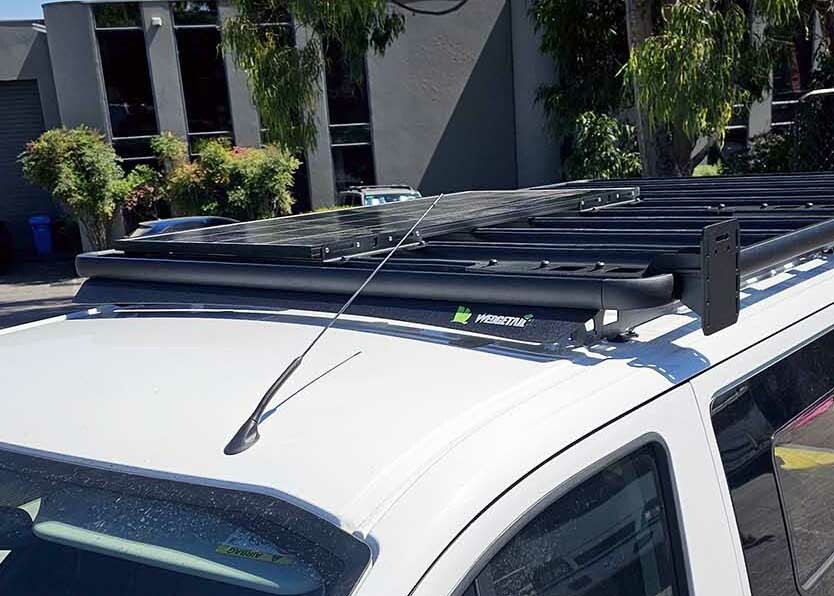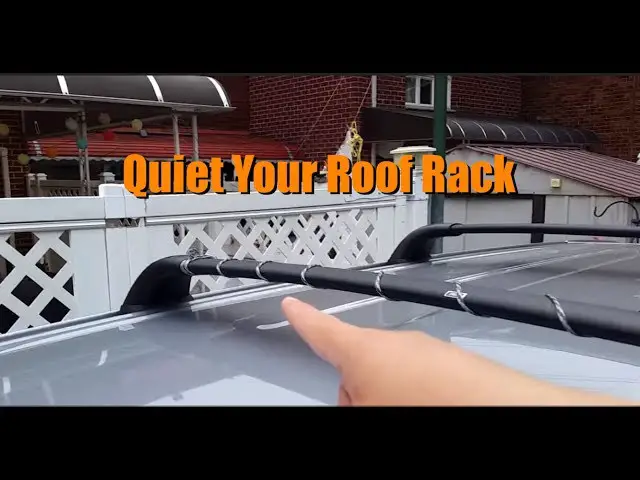To stop roof rack noise, tighten all bolts and screws and use aerodynamic crossbars. Adding rubber strips can also help.
Roof rack noise can be a real nuisance during drives. The whistling or humming sound often comes from loose components or poor aerodynamics. Ensuring all bolts and screws are tightly secured can significantly reduce this noise. Using aerodynamic crossbars designed to minimize wind resistance can also make a big difference.
Adding rubber strips or pads between the roof rack and the car can further dampen vibrations and reduce noise. Regular maintenance and checks can keep your roof rack quiet and your drives more enjoyable. By addressing these issues, you can enjoy a quieter, more pleasant driving experience.

Credit: www.youtube.com
Identifying Roof Rack Noise
Identifying roof rack noise is the first step towards a quieter ride. Understanding the different sources and types of noise can help you address the issue effectively. Let’s dive into the common sources and types of noise your roof rack might produce.
Common Sources
Roof rack noise can come from various sources. These sources can be easy to identify if you know where to look. Here are some common sources of roof rack noise:
- Loose Components: Bolts, screws, and clamps might loosen over time.
- Wind Resistance: The shape of the rack can create wind noise.
- Load Movement: Items on the rack can shift and cause noise.
- Vibration: The rack itself can vibrate, producing noise.
Noise Types
Understanding the types of noise can help you pinpoint the problem. Here are the common types of noise produced by roof racks:
- Whistling: This is often caused by wind passing through gaps.
- Rattling: Loose parts or unsecured loads can rattle.
- Humming: This noise is usually due to vibrations.
- Squeaking: Friction between components can cause squeaking sounds.
A quick inspection can often reveal the source of the noise. Tightening bolts and securing loads can reduce or eliminate many noises. For persistent issues, consider adding aerodynamic fairings or wind deflectors to your setup.
Proper Installation
Proper installation of your roof rack is crucial to stop noise. A well-installed rack reduces wind resistance and vibrations, ensuring a quieter ride. Follow these simple steps to make sure your roof rack is installed correctly.
Securing Components
Ensure all components are tightly secured. Loose parts can rattle and cause noise. Double-check each bolt and screw.
- Use a torque wrench for accurate tightening.
- Check for any missing washers or spacers.
- Verify that all clamps are firmly in place.
Refer to the manufacturer’s manual for specific torque settings. Properly secured components minimize vibrations and noise.
Checking Alignment
Align the roof rack properly on your vehicle. Misalignment can increase wind noise.
- Ensure the crossbars are parallel.
- Position the rack centrally on the roof.
- Check for even spacing between crossbars.
Use a measuring tape for accurate alignment. Proper alignment ensures even weight distribution and reduces noise.
| Component | Check |
|---|---|
| Bolts | Tighten with a torque wrench |
| Clamps | Ensure they are firm |
| Crossbars | Align parallel and central |
Proper installation is key to a quieter, more enjoyable ride. Always follow the guidelines for securing and aligning components.
Aerodynamic Solutions
Roof rack noise can be annoying and distracting. Aerodynamic solutions can help reduce this problem significantly. By minimizing wind resistance, you can enjoy a quieter ride.
Fairings And Wind Deflectors
Fairings and wind deflectors are great tools for reducing roof rack noise. These devices redirect airflow to minimize turbulence. They are easy to install and effective.
- Fairings – Attach these to the front of your roof rack.
- Wind deflectors – These go along the sides of your rack.
Both options can make your car much quieter. They are also affordable and available in many sizes.
Low-profile Racks
Low-profile racks sit closer to your vehicle’s roof. This design reduces wind resistance and noise. They are sleek and often more aerodynamic than standard racks.
| Feature | Standard Racks | Low-Profile Racks |
|---|---|---|
| Height | Higher | Lower |
| Wind Resistance | More | Less |
| Noise | Louder | Quieter |
Low-profile racks are a smart choice for reducing noise. They are also stylish and easy to use.

Credit: tradesmanroofracks.com.au
Padding And Insulation
Roof rack noise can be annoying. Padding and insulation help reduce this noise. By using simple materials, you can make your rides quieter. Here’s how to use foam pads and weather stripping for this purpose.
Foam Pads
Foam pads are great for damping noise. They absorb vibrations and reduce clattering.
- Measure the areas where the roof rack meets the car.
- Cut foam pads to fit these spots.
- Attach the foam pads using double-sided tape.
Using foam pads can make a big difference. They are easy to install and effective.
Weather Stripping
Weather stripping helps seal gaps and reduce noise. It’s usually made of rubber or foam.
- Clean the area where you will apply the weather stripping.
- Measure the length needed for each section.
- Cut the weather stripping to the correct length.
- Peel off the adhesive backing.
- Apply the weather stripping along the edges.
Weather stripping not only reduces noise but also protects your car. It keeps water and dirt out.
Maintenance And Inspection
Proper maintenance and regular inspection of your roof rack can help reduce noise. This ensures your roof rack stays secure and functions well. Let’s break down how to keep your roof rack in top shape.
Regular Tightening
Loose bolts and fittings can cause annoying rattles and vibrations. Regularly check all bolts and screws on your roof rack. Use the right tools to tighten them securely.
To make this easier, follow these steps:
- Identify all bolts and screws.
- Use a wrench or screwdriver to check tightness.
- Apply thread locker for extra security.
Spotting Wear And Tear
Inspect your roof rack for any signs of wear and tear. Look for rust, cracks, or other damages. These can create noise and weaken the structure.
Here’s a quick checklist:
- Examine the metal parts for rust.
- Check plastic components for cracks.
- Look at rubber parts for wear.
If you find any damage, replace the affected parts immediately. Keeping your roof rack in good condition ensures a quieter ride.
Load Distribution
Proper load distribution is crucial to minimize roof rack noise. Uneven loads cause wind resistance and vibrations. These lead to unwanted noise during your journey.
Even Weight Distribution
Ensure even weight distribution across the roof rack. This helps balance the load and reduces wind drag.
- Place heavier items at the center.
- Distribute lighter items around the heavier ones.
- Check that the weight is balanced side-to-side.
Improper weight distribution causes more noise and affects vehicle handling. Always double-check load placement before starting your trip.
Securing Loose Items
Securing loose items is vital for reducing roof rack noise. Loose items rattle and create noise while driving.
- Use bungee cords or straps to tie down items.
- Ensure all straps are tight and secure.
- Check for any loose ends that might flap in the wind.
For small items, consider using a roof box. A roof box encloses items, reducing noise and wind resistance.
| Tips | Benefits |
|---|---|
| Use padding between items | Prevents rubbing and noise |
| Check regularly during long trips | Ensures items remain secure |
Selecting The Right Rack
Choosing the right roof rack is crucial to reduce noise. A well-selected rack minimizes drag and wind resistance. This can make your ride much quieter and more enjoyable.
Material Considerations
The material of your roof rack significantly impacts noise levels. Different materials offer varying degrees of noise reduction and durability.
| Material | Noise Level | Durability |
|---|---|---|
| Aluminum | Low | High |
| Steel | Medium | Very High |
| Plastic | High | Medium |
Aluminum racks are lightweight and produce less noise. They are also resistant to rust.
Steel racks are more durable but can be noisier due to their weight.
Plastic racks are affordable but tend to be the noisiest. They also wear out faster.
Design Features
The design of your roof rack also plays a role in noise levels. Different design features can help reduce wind resistance.
- Aerodynamic shape: Racks with an aerodynamic design cut through the wind more efficiently.
- Low-profile: Low-profile racks sit closer to the roof, reducing wind noise.
- Wind fairings: These are accessories that deflect wind away from the rack, lowering noise.
Choosing a rack with these design features can make your travel quieter.

Credit: www.instructables.com
Professional Assistance
Sometimes, solving roof rack noise requires professional help. Experts can diagnose and fix issues efficiently. Professional assistance ensures your roof rack operates quietly and effectively.
When To Seek Help
If you hear persistent noise despite DIY efforts, seek professional help. Unusual sounds indicate potential damage or misalignment. Professionals can identify and solve the problem quickly.
Consult an expert if you notice loose or damaged parts. They have tools and knowledge to repair or replace components. This ensures your roof rack remains safe and quiet.
Expert Installation Services
Professional installation services guarantee proper setup of your roof rack. Experts ensure all parts are securely fastened and aligned. This minimizes wind noise and enhances safety.
Consider expert installation for complex roof racks. Professionals have experience and tools to handle intricate designs. This reduces the risk of noise and damage.
| Signs You Need Professional Help | Benefits of Expert Installation |
|---|---|
| Persistent noise | Proper alignment |
| Loose parts | Secure fastening |
| Damaged components | Reduced wind noise |
Hiring professionals for your roof rack ensures peace of mind. It saves time and effort, offering a reliable and quiet solution.
Frequently Asked Questions
How Can I Reduce Roof Rack Noise?
To reduce roof rack noise, ensure it’s properly installed and secured. Use aerodynamic crossbars and fairings. Remove the rack when not in use. Regularly check for loose parts and tighten them.
Why Does My Roof Rack Make Noise?
Roof rack noise is often caused by wind resistance. Misaligned or loose components can increase this noise. Proper installation and aerodynamic designs help reduce it.
Are There Specific Roof Racks That Are Quieter?
Yes, aerodynamic roof racks designed to minimize wind resistance are quieter. Brands like Thule and Yakima offer such models. They reduce wind noise effectively.
How Do I Know If My Roof Rack Is Installed Correctly?
Check the manufacturer’s instructions for proper installation. Ensure all components are tight and secure. Listen for unusual noises during your drive.
Conclusion
Eliminating roof rack noise enhances your driving experience. Use proper installation, padding, and aerodynamic designs. Regular maintenance is crucial. Following these tips ensures a quieter, more enjoyable ride. Invest in quality gear for long-term peace of mind. Enjoy the silence and focus on your journey.

